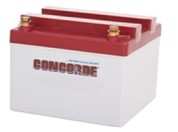Mon, Jul 26, 2010
Concorde Battery Discusses Parasitic Drain
 Concorde recently issued Technical Bulletin No. 10 "Parasitic
Drain", in response to questions throughout the aviation community
about the effect of parasitic drain on battery state of
charge. A parasitic drain is an electrical load that takes
power from the battery even when the Master Switch or Battery
Switch is Off. Examples of loads that cause parasitic drain
include clocks, lights, relays, current sensors and power
monitoring circuits. If an aircraft is inactive for a length
of time, depending on the magnitude of the load, the battery may be
depleted within weeks or even days.
Concorde recently issued Technical Bulletin No. 10 "Parasitic
Drain", in response to questions throughout the aviation community
about the effect of parasitic drain on battery state of
charge. A parasitic drain is an electrical load that takes
power from the battery even when the Master Switch or Battery
Switch is Off. Examples of loads that cause parasitic drain
include clocks, lights, relays, current sensors and power
monitoring circuits. If an aircraft is inactive for a length
of time, depending on the magnitude of the load, the battery may be
depleted within weeks or even days.
Skip Koss, Vice President of Marketing says, "When an aircraft
is not in service, a parasitic drain will deplete the battery's
state of charge unless the drain is disconnected." Mr. Koss
explains, "I am concerned about the increasing number of aircraft
affected by parasitic drain which can diminish emergency capacity
reserves and compromise the safety of pilots and passengers."
Parasitic loads are present in most modern day aircraft.
They are generally low in amperage but because they are
continuously present, if an aircraft is inactive for an extended
period of time, they can deplete the battery's capacity and cause
the plates to sulfate. Sulfated plates make the battery
harder to recharge and over time can lead to a battery that is no
longer airworthy and ultimately, premature failure. One of
the inherent dangers is that a battery without enough emergency
power reserve can often still start the engine(s). A battery
that is no longer airworthy can also cause an AOG event with
unexpected expenditures for obtaining an urgent replacement,
freight, installation and possibly costs for transportation back
and forth to a hotel for overnight accommodations.

To preserve the life of your battery, Concorde recommends
measuring the parasitic drain which can be easily accomplished
using a standard digital multimeter (DMM) equipped with both 10 Amp
and milliampere jacks for test leads. Details for this
procedure and a formula to calculate the depletion rate can be
found in Technical Bulletin No. 10 "Parasitic Drain" on the
Literature, Manuals and Technical page of the Concorde Battery
website. In some aircraft, modifications can be made to reduce or
eliminate the parasitic drain however, the airframe manufacturer
should be contacted for information on this subject.
Concorde says the best practice to protect an inactive aircraft
battery from parasitic drain is to disconnect it, if possible!
More News
Pilot Also Reported That Due To A Fuel Leak, The Auxiliary Fuel Tanks Were Not Used On June 4, 2025, at 13:41 eastern daylight time, a Piper PA-23, N2109P, was substantially damage>[...]
Have A Story That NEEDS To Be Featured On Aero-News? Here’s How To Submit A Story To Our Team Some of the greatest new stories ANN has ever covered have been submitted by our>[...]
From 2023 (YouTube Edition): Reflections on War’s Collective Lessons and Cyclical Nature The exigencies of war ought be colorblind. Inane social-constructs the likes of racis>[...]
Aero Linx: Colorado Pilots Association (CPA) Colorado Pilots Association was incorporated as a Colorado Nonprofit Corporation in 1972. It is a statewide organization with over 700 >[...]
High Speed Taxiway A long radius taxiway designed and provided with lighting or marking to define the path of aircraft, traveling at high speed (up to 60 knots), from the runway ce>[...]
 NTSB Prelim: Piper PA-23
NTSB Prelim: Piper PA-23 ANN FAQ: Submit a News Story!
ANN FAQ: Submit a News Story! Classic Aero-TV: One Mans Vietnam
Classic Aero-TV: One Mans Vietnam ANN's Daily Aero-Linx (07.03.25)
ANN's Daily Aero-Linx (07.03.25) ANN's Daily Aero-Term (07.03.25): High Speed Taxiway
ANN's Daily Aero-Term (07.03.25): High Speed Taxiway




